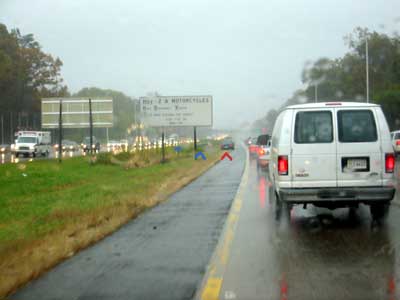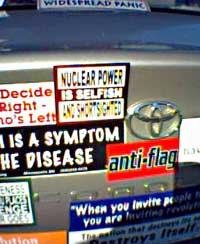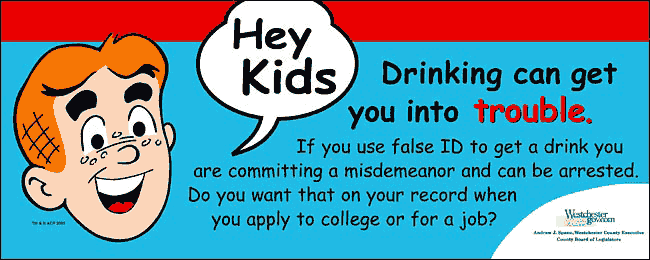
|
|
|
Tuesday 28 October 2003
Traffic Suggestion Here’s the scene at 11:30 a.m. yesterday on Interstate 66 in Fairfax, Virginia: It’s hard to see all this in the small picture above, so you might want to click on the photo to pop up a larger version. There’s a red arrow pointing to a police car on the shoulder here, with its cop lights on. The lights didn’t show up in the photo. There’s a blue arrow pointing to a minivan off in the ditch, the reason the cop was there in the first place. There were no other people around, no signs of activity at all; just the cop in his car, and the empty minivan that had been driven into the ditch. Traffic was moving at about 10 mph for five miles downstream from this in both directions, and perfectly clear, 60 mph flow afterwards. This wasn’t mentioned in the four or five traffic reports I heard on the radio while I was approaching and stuck in this mess, of course. Washington-area traffic reports are legendarily bad; I have, more than once, been sitting in traffic at a standstill across all lanes of interstate highways in Washington, and heard multiple traffic reports fail to say anything about it. Anyway, so there we’ve got a total of ten miles of cars backed up In the rain. Thousands of cars, moving in fits and starts a few feet from one another, full of impatient drivers. It seems to me highly unlikely that whatever that cop was doing there was immediately vital enough to justify the increased risk of accidents — to say nothing of the time wasted by all those people in traffic — that resulted from his flashing-light act on the side of the road. The Washington Post has a series (link goes to first article) this week on quick & dirty fixes for Washingtonia’s traffic problems. The theme is that things like building new bridges and interchanges is great, but that these things take ten years and billions of dollars; it’s worth looking at the low-hanging fruit, too. In Washington, the low-hanging fruit is almost totally ignored; the things the Post writes about are things like synchronizing traffic lights. Really. That counts as insightful here. Anyway, in my experience, one of the simplest and most-fruitful quick fixes would be to get the damned police to start thinking about the consequences of their actions, to tell them that their look-at-me tactics will no longer fly. Were the police genuinely interested in traffic safety rather than in revenue generation and the intimidation of the public, they’d figure this out on their own. I understand that the point of the police lights is to keep people from running into the cops when they’re on the side of the road, and I have no problem with that. The police don’t need to run the risk of being run over. But if the goal here is to keep the police safe from possible collisions, it’s possible to make things a hell of a lot safer by simply getting them off the road entirely The police need to stop making traffic stops in traffic lanes (I’ve seen this happen a number of times). If there’s no shoulder, the cop needs to tell the person he’s stopped to drive to a parking lot or a side street somewhere nearby. The risk that a right-turn-on-red violator will thus get away is much less than the risk of accidents and congestion because of blocked traffic lanes. Even where there is a shoulder, for God’s sake you can generally get off the main road into a parking lot or something, and you probably should. There, you can turn off the lights and stop distracting drivers and drawing gawkers. And, finally, when more than one police car is involved in a roadside event, there’s no need for them to all have their lights going, attracting attention. It’s not just a matter of there being more light; when you’ve got more than one of these things going in close proximity, and they’re operating out of phase with each other, they’re a hell of a lot more dazzling than the lights on a single car. If it’s too dangerous for a police car to be sitting with its lights off within a few feet of another police car with its lights on, then it’s too dangerous for the people stopped for traffic violations to be sitting in their cars in a similar situation, and all traffic stops should cease immediately. I don’t think this is the case, though. Obviously none of this applies when the cops are involved in some true emergency; but the truth is that very few of these situations meet the definition of an emergency. The legislatures and the police are all up in arms about ‘distracted driving’ of late, but to the best of my knowledge nobody has pointed out that creating a spectacle of flashing lights along the side of the road is more than a wee bit distracting. And while billions of dollars are being spent to try to ease the pain of traffic congestion, and everyone’s noticed that police activity on the side of the road invariably leads to miles-long traffic backups, nobody’s yet suggested that perhaps there’s a need for a change in police roadside procedures. As the Post’s articles this week point out, there are a lot of cheap and easy solutions to some of our traffic problems. There are a lot more simple improvements that can be made, though, than the Post mentions; but the biggest challenge is actually getting people to take the problem seriously. We talk about there being a traffic ‘crisis’, but as yet there doesn’t seem to be any genuine recognition that the fact that traffic crawls along fully half the time is anything but an annoyance. Posted by tino at 21:39 28.10.03
Customer Service
Bad User Interface Bites Back So the K-Mart here in Front Royal has, it seems, decommissioned their self-checkout lanes. They’re currently being used to display 7-Up cakes and Dracula costumes.  The problem with these things wasn’t that they weren’t needed; they are. On weekends, this understaffed K-Mart has long lines at all the tills, and certainly loses business from people who just don’t feel like standing around waiting to hand over their money. The problem was that these were self-checkouts of the bags-on-a-scale variety. These try to keep the customers honest by weighing the bags after every item is scanned; if the weight of the bag doesn’t increase by the amount the system thinks it should increase, the recording barks at the customer, telling him to remove the last item from the bag. Every place I’ve seen with one of these has the same problem. So because the store lives in terror that a customer might try to slip unpaid-for items into the bags, these do-it-yourself tills make life even harder for the customers. The customers are now faced with the choice of dealing with these annoying machines, or waiting in the long lines; they decide instead to go somewhere else entirely. Today’s businessman seeks to improve his own profit margin while not taking on any increaseed risk or uncertainty of any kind himself. Self-service tills that were not so paranoid would be useful, but, yes, they would result in increased shrinkage as customers walked out of the store with a few items they hadn’t paid for. Shrinkage could be reduced to near zero, however, by returning to the style of retailing of a century ago, where customers came up to the counter and told the clerks what they wanted. The clerks got the merchandise from shelves that were not accessible to the public, and presented it to the customer. As it turns out, this isn’t very good for the retailer, as it’s a labor-intensive system, and it pretty much eliminates the possibility of impulse purchasing. The modern retailer understands that the risk from shoplifters is offset by the advantage of having the customer fetch his own goods. We’re lucky that retail made this leap decades ago, because it probably wouldn’t be tried today. Posted by tino at 16:36 28.10.03
Saturday 25 October 2003
General Idiocy
Selfish Activism Sticker seen on a car in a parking lot in Front Royal:
Nuclear power is selfish and shortsighted, according to this Corolla driver. Now, it goes almost without saying that I don’t agree with this bumper sticker. But, more than that, I don’t even really understand it. Nuclear power is selfish and shortsighted? What the hell does that mean? I assume that it’s nuclear power (as opposed to nuclear power) that’s being complained about here. The ‘selfish’ part is most bewildering. I think it’s just used because ‘selfish’ is the worst thing the antis can call something. Plus, Dick Cheney has been quoted as supporting nuclear power, so it must be selfish. And it would be a lot more shortsighted to continue burning coal and oil (both of which spew lots of radioactive and otherwise nasty gunk into the air when burned, even in modern plants) simply to avoid facing the challenge of finding something to do with nuclear waste. The shortsighted position is to assume that because we don’t have a perfect process for dealing with nuclear waste now, we never will have one. Posted by tino at 14:22 25.10.03
Thursday 23 October 2003
Transit
Headline: Metro Warns of Poor Service
A cynic would say that the trains and buses already break down frequently, the platforms and trains are already jammed, and buses are already delayed. In fact, I’ll say it: the trains and buses already break down frequently, the platforms and trains are already jammed, and buses are already delayed. I suppose it could all be worse, though. Another reason for transit systems to support themselves without subsidies. Posted by tino at 08:37 23.10.03
Saturday 18 October 2003
Corporate Idiocy
Synergy, The Wrong Way So in the course of my daily rummaging, I come across this article, and want to read it. Trouble is, it’s from Time magazine a few months ago, which means it’s been moved into the archives. To read a story in the archives costs you “as little as” $2.50, or about what the whole magazine costs each week. No, thanks. If you’re a Time magazine subscriber — which I’m not — you get access to the last 52 weeks of articles, and discounts on access to older parts of the archive. Aha, I think. I have an AOL account, and AOL is, remember the company that bought Time magazine and its parent company, lock, stock, and barrel, a few years ago. And my AOL account is not just any AOL account, but a super-VIP AOL account that comes with unlimited use of everything and with no charges, ever. So I fire up AOL and paste in the URL. They still want $2.50 from me. If I subscribed to Time for $29.95 a year, I’d have access. But since I subscribe to AOL, for what would ordinarily be not much less than that per month, they still want more. Now, of course, AOL and its media properties are free to charge anything they’d like for their information, and they’re under no obligation to give freebies to AOL subscribers. They are, however, obligated to attempt to make as much money as possible for their shareholders. And they’re doing this how? By reducing the value of their $24/month product in order to increase the value of their $29/year product. Posted by tino at 17:07 18.10.03
Friday 17 October 2003
Random Photograph
You Pay Now! I’m lazy, so for now I’m going to just continue posting pictures of strange things I’ve seen. This is a poster I saw today in the Warren County Government Center, a converted IGA supermarket in the middle of Front Royal. It advertises some kind of Virignia tax amnesty program.
I’m sure they think this is light-hearted. I suppose it never crossed their mind that “Pay now or pay more later” is possibly not the least-antagonistic thing you could say to taxpayers — especially since I’ll bet nearly everyone looks at this, and, as I did, thinks to themselves that this is a bit different from the normal tax routine of “Pay now, and pay more later”. Posted by tino at 18:43 17.10.03
Thursday 16 October 2003
Random Photograph
Choctoberfest A poster seen in the window at Baskin-Robbins the other day:
Posted by tino at 15:41 16.10.03
Tuesday 14 October 2003
General Idiocy
School Performance, Poverty, and ‘Diversity’ There’s a story in today’s Washington Post about the Montgomery County school system. Montgomery County, Maryland, is a relatively wealthy jurisdiction just north of Washington, DC. It’s also quite ‘diverse’. ‘Diverse’ here is a code word for ‘non-white’. If your county is entirely black, it’s ‘diverse’. If it’s entirely white, it is, obviously, not. As it happens, Montgomery County is actually diverse, when you’re talking about skin color, in a sane sense as well; which is to say that many different color of skin are represented there. Montgomery County’s public school system is a good one, taken as a whole. But.
This despite being part of a school system which demonstrably does not waste much of its money on bureaucracy and aggrandizement of its own honchos; the system has no trouble educating half of its students. The Montgomery County schools have even taken special steps to help students in the ‘red zone’:
It hasn’t worked, of course. Even within a good school system, and even with more resources being focused on the ‘red’ schools, the children of the poor still lag behind. And the situation is not going to improve until it becomes socially acceptable to address the real problem: that, within the United States, there are cultures which tend to lead their members to success, and cultures which tend not to lead their members to success. Many ‘minority’ American cultures are not ones that lead to success. I’m not going to go into this at length here. Gasp! Shock horror! Can’t say that, it’s racist! Well, no it isn’t, unless you think — as most of the Left does these days — that skin color is the major determinant of your character. Let’s leave skin color out of it, and examine the facts. Or, rather, the fact that seems to be universal in all the education hand-wringing: poor children do less well in school than wealthier children. Children don’t work, of course, so poor children are the children of poor parents. Parents who are poor are people who have not figured out how to succeed — economically, at least — in our society. Wealthier parents have, by definition, themselves been more successful in our society. They know how to play the game, and they teach this — often unconsciously — to their children. So rather than saying black children don’t do well in school or Hispanic children don’t do well in school or even poor children don’t do well in school, we might say: children of unsuccessful parents tend to be unsuccessful in school. There are exceptions, of course, just as some millionaire’s sons get expelled. But generally, it holds true. And it’s because poor parents are poor because they don’t have the skills to be successful. They’re not lazy; they’re not stupid; they’re not genetically inferior. Poor people — most of them — merely lack the knowledge necessary to not be poor. As with the millionaire’s son, there are exceptions. Some people are poor because they are genuinely unable to acquire any valuable skills; there are a lot of smart poor people, but very few genuinely stupid and incapable wealthy people (except heirs). Some people are poor because of bad luck; certainly a lot of wealthy people have happened to be in the right place at the right time (like, dare I say it, heirs). Some people are poor because they’ve made a positive decision to live their lives in some way that’s not particularly remunerative. Most poor people, though, are poor because they don’t know how not to be poor. They’d like to be more successful, but they don’t know how: they have some vague ideas about education, and working hard, and so on, but they don’t really have much of an idea of what ‘education’ means, other than ‘schooling’. They know about working hard, but they work hard at the wrong things. And their kids learn these things from them. What’s needed isn’t No Child Left Behind, or federal breakfast programs, more money, or all-day kindergarten, or any of the other garbage that passes for Educational Reform. What’s needed is a public acknowledgment by mainstream society that certain behaviors and values tend to lead to success, and that certain behaviors and values don’t. And that the values and behaviors that tend to lead to success are those held and practiced by the ‘majority’ culture. It’s possible to be a great success in the United States without being able to speak English, and it’s possible to get rich while remaining ‘true’ to some ghetto culture. It’s far more likely that you’ll get rich while wearing a tie, and while speaking the langauge of the majority. Once you’re rich, you can do pretty much whatever you like within the walls of your compound. Is this what’s likely to happen, now that we’ve seen children within a single school system but from varying cultures have different rates of success? Of course not. [Gary] Orfield [professor and co-director of Harvard University’s Civil Rights Project], who researched Montgomery County for his book “Dismantling Desegregation,” said policymakers should look at ways beyond the schools to maintain true diversity, in which populations — and therefore political power and family resources — are more evenly balanced. Think about that: Policymakers should look at ways … to maintain true diversity, in which populations … are more evenly balanced. Which seems to mean that where you’ll be allowed to live should depend on your skin color. If a neighborhood is too white, it’ll be ‘diversified’ by the addition of some ‘minorities’. If it’s too black… well, you’d think that with today’s emphasis on diversity über alles, this would be good, but no, it’s ‘gentrification’ and it’s bad. So I’m not sure what would happen in that case. And I have to assume that mixed-race people would once again be classified as ‘quadroon’ and ‘octoroon’ and all manner of idiotic BS, and used to fine-tune ‘neighborhoods’ where only three-quarters (or three-fifths) of a white person needs to be balanced. But in any case, ‘true’ diversity must be achieved at all costs, it seems. And note than while the problem is one of academic achievement (and, by my assessment, social skills and wealth as a proxy for those skills), the civil rights poobahs immediately turn it into one of race. Race, the topic that can’t be discussed in America. White people living as black people do in America’s cities and cheaper suburbs would be told, in no uncertain terms, to stop living that way; that their poverty, unhappiness, and failure was the result of their lifestyle. The race-hucksters, though, have managed to convince a large enough majority of the people that, somehow, living off the government dole, working miserable jobs, and going through life with a only a rudimentary education (if that) are authentically black, and that somehow being successful in the mainstream society means selling out to The Man. We hear people like Colin Powell and Condoleezza Rice called ‘sellouts’ and ‘house slaves’. People say that Tony Wililams, the mayor of Washington, DC, isn’t ‘black enough’; presumably, Marion Berry, the unbelievably inept and corrupt crack-head prior mayor, was ‘black enough’. So the ambitious ‘minority’ person not only has to fight against a lack of social knowledge about how to succeed in our society, but he’s got to deal with jackasses who tell him that by following his ambitions, he’s somehow less authentically himself. And so, even when the laboratory of Montgomery County has shown us how students from different cultures perform differently in the same school system, we can’t even publicly acknowledge that the problem might, just might be the culture that the unsuccessful kids come from. Ah, yes. Of course. Until we can’t face the fact that the worship of ‘multiculturalism’ and ‘diversity’ for diversity’s sake short-circuits cultural evolution, we will not be rid of these problems. Our society was poorer in the past for the suppression of the cultures of blacks and other ‘minorities’; it’s poorer now for the unexamined celebration of these cultures. Posted by tino at 23:58 14.10.03
Friday 10 October 2003
Random Interesting Thing
Christmas Is Coming Here we are, not even halfway through October, and Christmas decorations have already appeared in the stores. For sale, at least; not too many places have decked the places out with holly and Santa Clauses yet.
I love Christmas, even the commonly-sneered-at ‘commercialized’ Christmas. I love mall Santas, and Christmas music everywhere, and wreaths of the fronts of the cars of the deranged, and Christmas-themed soft-drink packaging, and all of it. If there were a Power Rangers Christmas Special, I’d probably watch it. But, while I am anxious for Christmastime to come, and while I am generally not one of these people who complains about Christmas decorations appearing in public too early, it does occur to me that having Christmas year-round would spoil it somewhat. They’re definitely pushing it this year. Posted by tino at 22:51 10.10.03
Thursday 09 October 2003
Government Idiocy
Hey Kids! The New York Times reports that Westchester County is going to start using Archie Andrews and friends (Reggie, Betty, Veronica, Jughead, etc.) in a campaign to encourage kids not to drink, smoke crack, join the Communist Party, etc., etc., etc. Part of the initial campaign is this bus ad:
I cannot believe the ham-fistedness of this. Encouraging kids not to drink: that’s fine. But I cannot help but notice that every reason they give not to drink has to do with external threats. It’s not “Don’t drink because you’ll likely behave like an idiot for a few hours, and then puke your guts out” — this is how most teenagers drink — it’s “Don’t drink because the judicial hammer will (may) come down on you.” It’s not about teaching kids to make the decision not to drink on their own; it’s about teaching kids to fear the wrath of the police state. This doesn’t seem to be the most-effective anti-drinking campaign possible, but then maybe that’s not the main purpose. And anyway, Archie? A grinning Archie Andrews, issuing these legal threats and prefacing them with a jovial ‘Hey kids’? Good Lord, what are they thinking? I’ll tell you what they’re thinking. First of all, the Westchester Youth Alcohol Board (or whatever) is thinking that kids today have any idea who Archie is. They’re not considering that youth culture might have moved on since 1975, when Archie was, if not popular, at least recognized. And, second, they appear to be under the impression that kids — teenagers, mainly — drink in violation of the law because they’re not aware of the potential penalties. This strikes me as unlikely, what with today’s mandatory drug-‘education’ propaganda classes, and the presence of police officers in ‘educational’ programs in most public schools. The kids are not unaware that using a fake ID is illegal; they just don’t give a shit. Most legislatures in the United States, including the Congress, seem to have forgotten the lessons of the past: that you can’t really change society by passing more laws, or by enforcing existing laws more vigorously. We’ve seen this throughout history, most recently with alcohol prohibition in the 1920s and with the War on Drugs and the copyright battles today. For a law to actually be effective, society has to believe in the law. An effective law reflects the will of the society; society does not, outside of a police state, easily bend to the will of the law. Society just doesn’t consider under-age drinking that big of a problem. Oh, sure, nobody’s in favor of twelve-year-olds getting loaded, but this particular bus ad is clearly about people who can pass as adults. No even marginally ethical person will sell liquor to a twelve-year-old, regardless of what his ID says. The kids who can buy liquor are 17- and 18-years old or older. Many of them can drink legally in most of the world, and most of their parents grew up when 18-year-olds could drink legally in the United States, before Libby Dole federalized the drinking age at 21. These parents, their kids, and most of the rest of American society, recognize that while there are some risks involved in drinking — by anyone of any age — it’s not really that big a problem. I could understand, though not agree with, an attempt to change that opinion. I can’t understand the impulse to take out advertisements to scare people into compliance with the law. If all that’s keeping people from doing x is the risk of punishment (and not an actual societal consensus that x shouldn’t be done), the premise of your law is faulty. And this is before you get to the whole Archie thing. Posted by tino at 15:41 9.10.03
Wednesday 08 October 2003
Government Idiocy
The War On The Poor (Housing Front) The War On The Poor continues apace, at least in Montgomery County, Maryland. One of the recurring themes here at Tinotopia is the outlawing of poverty. We think that this is a Victorian issue, but a lot of what present-day governments do involves making it illegal to be poor. None of these laws are actually called the Outlawing Poverty Act, but that’s the effect. And Montgomery County has now made it illegal to build houses without built-in sprinkler systems. The problem with this is that it’s hard to be against it. You don’t want people to have sprinkler systems in their houses? What, do you want them to burn to death? You don’t hate children, do you? So these kinds of measures tend to pass unanimously, as this one did. The problem is that things like putting trunk releases in cars, or sprinklers in houses, address very, very marginal risks. According to the state of Maryland, in the last five years an average of 6.2 people a year have died in fires — of any kind — in Montgomery county. That’s .7 fire deaths per 100,000 people. More people are killed each year in Montgomery county by being run over by cars than die in fires. Statewide, 22% of Maryland’s fire deaths in 2002 (these numbers aren’t broken down by county or averaged over time) were due to vehicle accidents, arson homicide, or arson suicide, none of which would be prevented by sprinklers. If you’re trying to kill someone, or yourself, you can just disable the sprinklers. And God knows it’s possible to kill someone without setting them on fire. If we assume that 2002 is a representative year, and that Montgomery county’s causes of fire death are the same as those for the entire state, this tells us that 5.456 people on average die in fires that might possibly be prevented by more sprinklers in Montgomery county. So, if none of the 20%-30% of fires in Maryland that are of ‘unexplained’ origin are actually deliberately set; and if everyone in Montgomery county immediately had sprinklers in their houses tomorrow; and if all these sprinklers worked 100% of the time and never malfunctioned, as many as 5.456 lives per year could be saved, at a cost of… what?
$1.6 million for administrative costs alone in the next year and three quarters — notice that they appear to believe that the money for higher-priced permits and inspections after that will come from the Money Fairy — and a rise of ‘about 1%’ of new houses’ total cost. And further note that this assumes that houses are expensive; a sprinkler system runs about $2000-$5000, depending on the size of the house. The median price for a new single-family detached house in Montgomery County in 2001 was $289,000; so figure, using the county’s own figures, that the average sprinkler system will cost $2900. If Montgomery county continues to grow at the same rate, by 2025 the county will need over 218,000 more housing units; if the future is predicted by the past, half of these units will be single-family houses. (See here for the source of these statistics.) 109,000 houses times $2900 plus $1.5 million a year for permits and such (assuming the increases in fees predicted by the county itself will be about 50% of what they are now), equipping Montgomery county with sprinklers will cost $350 million, or about $15.8 million per year from now through 2025. If we assume that, in a sprinkler-less Montgomery county, fire deaths would rise at the same rate as the population, this would mean that 6.366 people per year would die in fires in 2025. If every one of these deaths were eliminated by spending $350 million — which they wouldn’t be, because a lot of people would still live in older houses — this would mean an expenditure of about $3 million per life saved. This is better than the estimated $37.5 million it costs to save someone who would otherwise die as a result of trunk entrapment, but it’s still a lot of money. It might be pointed out that sprinklers would prevent property damage as well as deaths, but sprinklers keep buildings from burning down, not from being damaged. A fire in a sprinkler-equipped house is less likely to spread and cause the house to be an entire loss, but keep in mind that once a sprinkler starts spraying, it keeps spraying until the water is shut off. And sprinkler heads can and do malfunction and spray water on rooms that are not on fire. This additional expenditure to reduce what is already a very small risk will have the result of making Montgomery county an even less affordable place than it already is.
But we don’t have firefighters in every house, 24 hours a day, despite the fact that this would almost certainly reduce fire deaths to near zero. Why is that? Because we, as individuals and as a society, have determined that the cost of keeping a firefighter in every house is greater than the value of eliminating the risk of fires. If we hadn’t, more people would install sprinklers in their houses even where they’re not required by law. If you’re very rich, spending an additional 1% for a little additional assurance that you house isn’t going to burn down isn’t a problem. I’d be surprised if Bill Gates didn’t spend an extra million dollars to install a sprinkler system in his house. But the cost of the sprinkler system relative to the cost of the rest of the house isn’t the important part here: it’s the cost of the sprinkler system relative to the net worth of the person buying the house. Bill Gates is, as I write this, worth $34.79 billion; that’s $34,790,000,000. For Bill Gates to spend a million dollars, then, on a sprinkler system, is analogous to someone with a mere one-million-dollar net worth spending… $30 on a sprinkler system. A $2900 sprinkler system is, to a millionaire, what a $100 million sprinkler system is to Bill Gates. Bill Gates’ entire house, the one featured in magazines and on TV, didn’t cost $100 million. My guess is that even Bill Gates thinks about it before spending $100 million. But ordinary people in Montgomery county — most of whom aren’t even millionaires, by the way — are being forced by the county council to spend this money, rather than assume a small risk. My guess is that next, the residents of the county will be hit up with tax increases to pay for subsidized affordable housing. And nobody will bother to draw the connection. Posted by tino at 16:05 8.10.03
Tuesday 07 October 2003
Random Interesting Thing
At Least They’re Honest Spotted at CompUSA: Posted by tino at 17:20 7.10.03
Wednesday 01 October 2003
Tinotopia Update
More Slackage I am in St. Louis again this week, and again too busy to write much. I’ll try to post some one-line mini-rants some time this week, and pictures.
Posted by tino at 10:50 1.10.03
|







